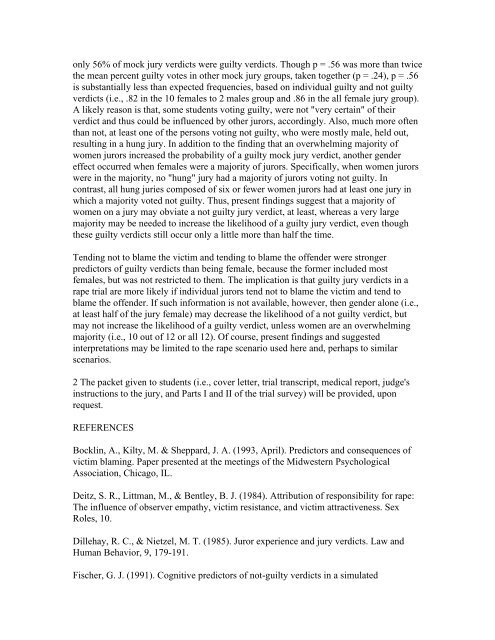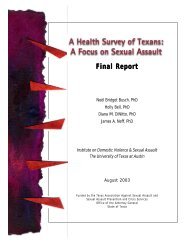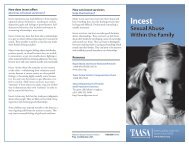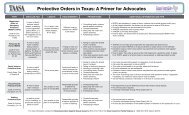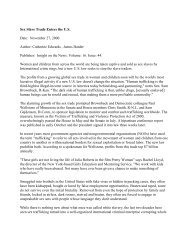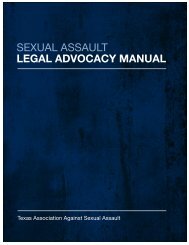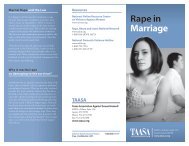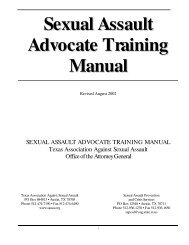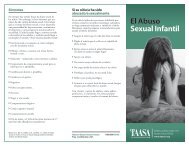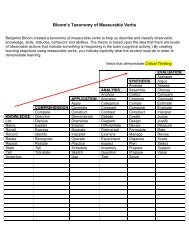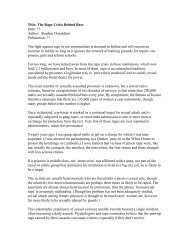Gender effects on individual verdicts and on mock jury verdicts in a ...
Gender effects on individual verdicts and on mock jury verdicts in a ...
Gender effects on individual verdicts and on mock jury verdicts in a ...
You also want an ePaper? Increase the reach of your titles
YUMPU automatically turns print PDFs into web optimized ePapers that Google loves.
<strong>on</strong>ly 56% of <strong>mock</strong> <strong>jury</strong> <strong>verdicts</strong> were guilty <strong>verdicts</strong>. Though p = .56 was more than twice<br />
the mean percent guilty votes <strong>in</strong> other <strong>mock</strong> <strong>jury</strong> groups, taken together (p = .24), p = .56<br />
is substantially less than expected frequencies, based <strong>on</strong> <strong><strong>in</strong>dividual</strong> guilty <strong>and</strong> not guilty<br />
<strong>verdicts</strong> (i.e., .82 <strong>in</strong> the 10 females to 2 males group <strong>and</strong> .86 <strong>in</strong> the all female <strong>jury</strong> group).<br />
A likely reas<strong>on</strong> is that, some students vot<strong>in</strong>g guilty, were not "very certa<strong>in</strong>" of their<br />
verdict <strong>and</strong> thus could be <strong>in</strong>fluenced by other jurors, accord<strong>in</strong>gly. Also, much more often<br />
than not, at least <strong>on</strong>e of the pers<strong>on</strong>s vot<strong>in</strong>g not guilty, who were mostly male, held out,<br />
result<strong>in</strong>g <strong>in</strong> a hung <strong>jury</strong>. In additi<strong>on</strong> to the f<strong>in</strong>d<strong>in</strong>g that an overwhelm<strong>in</strong>g majority of<br />
women jurors <strong>in</strong>creased the probability of a guilty <strong>mock</strong> <strong>jury</strong> verdict, another gender<br />
effect occurred when females were a majority of jurors. Specifically, when women jurors<br />
were <strong>in</strong> the majority, no "hung" <strong>jury</strong> had a majority of jurors vot<strong>in</strong>g not guilty. In<br />
c<strong>on</strong>trast, all hung juries composed of six or fewer women jurors had at least <strong>on</strong>e <strong>jury</strong> <strong>in</strong><br />
which a majority voted not guilty. Thus, present f<strong>in</strong>d<strong>in</strong>gs suggest that a majority of<br />
women <strong>on</strong> a <strong>jury</strong> may obviate a not guilty <strong>jury</strong> verdict, at least, whereas a very large<br />
majority may be needed to <strong>in</strong>crease the likelihood of a guilty <strong>jury</strong> verdict, even though<br />
these guilty <strong>verdicts</strong> still occur <strong>on</strong>ly a little more than half the time.<br />
Tend<strong>in</strong>g not to blame the victim <strong>and</strong> tend<strong>in</strong>g to blame the offender were str<strong>on</strong>ger<br />
predictors of guilty <strong>verdicts</strong> than be<strong>in</strong>g female, because the former <strong>in</strong>cluded most<br />
females, but was not restricted to them. The implicati<strong>on</strong> is that guilty <strong>jury</strong> <strong>verdicts</strong> <strong>in</strong> a<br />
rape trial are more likely if <strong><strong>in</strong>dividual</strong> jurors tend not to blame the victim <strong>and</strong> tend to<br />
blame the offender. If such <strong>in</strong>formati<strong>on</strong> is not available, however, then gender al<strong>on</strong>e (i.e.,<br />
at least half of the <strong>jury</strong> female) may decrease the likelihood of a not guilty verdict, but<br />
may not <strong>in</strong>crease the likelihood of a guilty verdict, unless women are an overwhelm<strong>in</strong>g<br />
majority (i.e., 10 out of 12 or all 12). Of course, present f<strong>in</strong>d<strong>in</strong>gs <strong>and</strong> suggested<br />
<strong>in</strong>terpretati<strong>on</strong>s may be limited to the rape scenario used here <strong>and</strong>, perhaps to similar<br />
scenarios.<br />
2 The packet given to students (i.e., cover letter, trial transcript, medical report, judge's<br />
<strong>in</strong>structi<strong>on</strong>s to the <strong>jury</strong>, <strong>and</strong> Parts I <strong>and</strong> II of the trial survey) will be provided, up<strong>on</strong><br />
request.<br />
REFERENCES<br />
Bockl<strong>in</strong>, A., Kilty, M. & Sheppard, J. A. (1993, April). Predictors <strong>and</strong> c<strong>on</strong>sequences of<br />
victim blam<strong>in</strong>g. Paper presented at the meet<strong>in</strong>gs of the Midwestern Psychological<br />
Associati<strong>on</strong>, Chicago, IL.<br />
Deitz, S. R., Littman, M., & Bentley, B. J. (1984). Attributi<strong>on</strong> of resp<strong>on</strong>sibility for rape:<br />
The <strong>in</strong>fluence of observer empathy, victim resistance, <strong>and</strong> victim attractiveness. Sex<br />
Roles, 10.<br />
Dillehay, R. C., & Nietzel, M. T. (1985). Juror experience <strong>and</strong> <strong>jury</strong> <strong>verdicts</strong>. Law <strong>and</strong><br />
Human Behavior, 9, 179-191.<br />
Fischer, G. J. (1991). Cognitive predictors of not-guilty <strong>verdicts</strong> <strong>in</strong> a simulated


